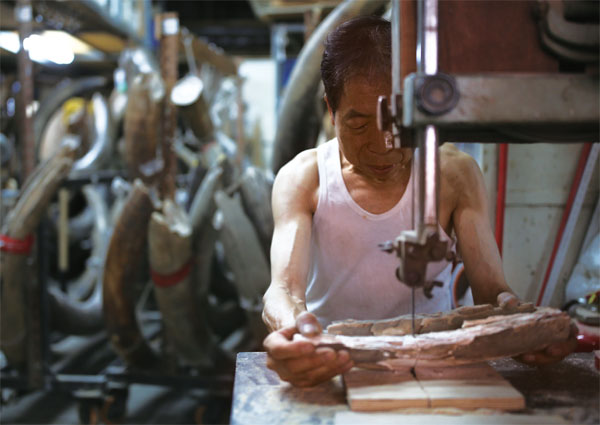The end of the Ivory Palace?
Updated: 2015-10-29 07:55
By Sylvia Chang(HK Edition)
|
|||||||

In view of the US-China agreement advocating a near-total ban on trading in ivory, a two-millennia-old industry in HK is on the verge of extinction. Sylvia Chang reports.
Over the last couple of months, ivory traders in the city have been meeting frequently, to commiserate the imminent extinction of their craft and two-millennia-old industry. The looming misfortune is the result of an agreement by leaders of the world's two largest economies, virtually banning all trade in ivory and its products. The China-US agreement is the latest, and possibly the ultimate, response to a global outcry over the wanton poaching of elephants, to supply an illicit, underground trade.
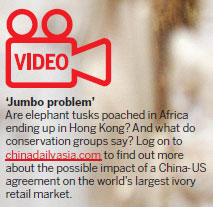
The men attending these gatherings are usually in their sixties. They have spent their working lives in Hong Kong, trading in ivory. They started out as apprentices, graduated to ivory carvers, learned the buying and selling of ivory, and many went on to open their own businesses. Today, in their twilight years, they cannot believe the trade in which they have earned their livelihoods is on the brink of extinction, like the elephants on whom their business depends.
"We're in the same boat with the elephants," laments ivory sculptor, Tung Pi-wang, who, at 58, reputedly is the youngest of Hong Kong's ivory carvers. "We love ivory like flies love decayed meat. That's how we live our lives." Most of his carvings are inspired by Chinese traditional drawings. He's won several international awards for his work.
On Sept 25 a statement released by the White House Press Office declared, "The United States and China commit to enact nearly complete bans on ivory import and export, including significant and timely restrictions on the import of ivory as hunting trophies, and to take significant and timely steps to halt the domestic commercial trade of ivory."
"We're going to die off before elephants are extinct," laments Daniel Chan Chun-bo, managing director of the Lise Carving & Jewellery Factory Limited in Hong Kong. He adds that only about several hundreds of practitioners remain in the ivory trade in the city. That's less than 1 percent of the number prior to 1989, the year that outrage over the wholesale slaughter of elephants finally boiled over and international efforts to ban the ivory trade intensified.
World's largest retailers
Hong Kong has more ivory items on sale than in any other city in the world, and is also a major transit hub, conservationists say, citing a report this year by Save the Elephant, a UK-based charity. The report reveals that between 2014 and 2015, more than 30,000 items of ivory, with an aggregate weight of 1.5 tons, were on sale at 72 retail outlets in Hong Kong. Most of the items were described as trinkets and small figurines.
"We believe that Hong Kong's ivory trade is fueling Africa's elephant poaching crisis," claims Gavin Edwards, director of conservation for the World Wide Fund for Nature - Hong Kong (WWF-HK).
On Oct 23, two conservation groups, WildAid and the African Wildlife Foundation, issued a joint call for a total ban on ivory sales and at the same time demanded an independent inquiry into the ivory trade here. Both sides blamed inadequacies in the SAR's regulation of the ivory trade. WWF-HK offered details of some of the regulatory lapses in a separate press release at the end of last month.
The releases came attached to photos of elephants, with their tusks hacked off by poachers. All three conservation groups blamed inadequate regulation by the HK government as well as ambiguities in ivory trading.
Government documents reveal that the weight of smuggled ivory seized by Hong Kong Customs officials between 2000 and 2013 totals more than 30 tons, equal to the weight of the ivory extracted from about 1,800 elephants. Conservationists say this does not represent the true picture, by far.
Statistics released under the Convention on International Trade in Endangered Species of Flora and Fauna (CITES) show that between 1989 and 2011, 70 percent of the ivory harvested globally found its way into China, much of it through smuggling.
Professor Zhang Li of the Institute of Ecology at Beijing Normal University says that demand for ivory is not the only motivation for the poaching of African elephants. "The consumption of ivory is a global issue, related to the regulations and to the corruption of the authorities in African countries as well," Zhang says.
Unchanged stockpile
In 1989, a ban on the international trade of ivory was implemented under CITES. However, the international agreement did not go so far as to ban Hong Kong's ivory traders from doing business, only restricted sales to registered stockpiles of ivory from animals harvested before 1990. Re-export from those stocks is prohibited under the CITES agreement.
Hong Kong government statistics show a 65 percent decline in the registered stock between 1989 and 2004 - from 665 to 236 tons. Between 2008 and 2010, the government had stopped keeping track of ivory registered for non-commercial purposes. Since then, the combined weight of the registered stockpile has remained relatively unchanged, in spite of the apparent surge of tourists on shopping trips to the city.
Conservationists question how this can be so, noting that while reserves have remained stable, there is high demand for ivory, fueled by a nearly astronomical increase in the number of mainland tourists, swarming the city in search of luxury items.
The stockpile, including raw material, is monitored by the Agriculture, Fisheries and Conservation Department (AFCD). In a recent e-mail response to enquiries from China Daily, a spokesman of AFCD says, "There is no correlation between the quantity of registered ivory stock under License to Possess and the number of tourists visiting Hong Kong." But no further insight was offered into the apparent anomaly that seems to suggest Hong Kong's ivory reserve is not being used.
Edwards of WWF-HK suspects that contraband ivory is "laundered" - shipped to Hong Kong among certified, authorized shipments of ivory. Loopholes in the regulations make laundering quite possible, he explains. Each piece of raw ivory or ivory that was partially worked before 1989 is certified with both a license and a serial number. The requirement for certification is waived for "finished" works. That's one loophole open to smugglers.
Another means of laundering is by shipping mammoth tusks together with elephant tusks, says Edwards. "Sometimes traders mix the two, and claim that they're trading only in mammoth ivory, which can be used as a front for continuing to sell illegal ivory."
Traders interviewed confirmed that the AFCD does not issue certification for finished works produced from the registered ivory stockpile. They also agreed that proper certification would make it much harder to launder contraband ivory.
In its e-mailed response, the AFCD said the department only recently introduced a marking system using "tamper-proof holograms and photographic records for ivory". The department assures that the new tactic will allow it to run "a comprehensive stock check" of ivory covered by Licenses to Possess. No timeline was provided for the completion of the work.
Is no one buying?
Some traders argue that the lack of significant decline in the local stockpile of ivory is the end result of a market collapse, i.e. there is no trading in ivory any more. Edwards rejects that argument. "I can't imagine 80 plus shops with licenses to sell ivory at locations around the city, where the rent is very high, like Hollywood Road (in Central), Nathan Road (in Tsim Sha Tsui), etc. How is it possible to run a business and claim that you're selling nothing?"
Traders counter that they are selling next to nothing. "Two or three years ago the Chinese market could take up to 100 tons per year, but now it's less than 10 tons," Chan estimates. He owns a manufacturing company on the mainland. The company's annual turnover "has declined to less than 20 percent of the peak trade", he contends.
Traders including Chan say they deal mostly in ivory from mammoths, which have been extinct for 10,000 years. Mammoth ivory is harvested in Russia and other countries close to the Arctic.
Chan says 90 percent of his trade is based on mammoth ivory which he has been buying since 1983. "Right now I only carve elephant ivories from my inventory when clients order them," says Chan, who claims to own two raw elephant tusks, and about one thousand kilograms of carved works. That's less than 10 percent of what he says he had in stock during the 1990s.
"The legal market for ivory is shrinking due to the rampant illegal trade. The same is true of the Chinese mainland," Zhang of Beijing Normal University notes. The State Forestry Administration of the Chinese government restricted the consumption of raw ivory to 5 tons per year. Zhang explains that demand last year fell short of the quota.
Ivories from pre-1975
Still, the market demand is hard to estimate. Hong Kong traders say that the existing stockpile is sufficient. They claim they are working with ivory which was in circulation prior to 1975 when the CITES regulations came into effect. Among that pre-Convention ivory are antique ivory acquired from auctions.
The import, re-export and trade in these ivories is permissible. According to AFCD, the quantity of pre-Convention ivory imported into Hong Kong in 2014 was about 4,152 kg, more than four times the amount of 989 kg in 2013. In 2010, only 21 kg was imported.
Simon Pong Tat-lei, 65, managing director of Cheung Shing Art Company, says that most pre-Convention ivory imported into Hong Kong is raw material - whole tusks. He says traders usually re-export these ivories to cities on the Chinese mainland and have them processed there.
This sole, lawful means of conducting ivory trade across borders is now to be wiped off the board. The China-US agreement, signed in September, suggests an almost complete ban on ivory imports and exports.
Zhang of Beijing Normal University calls the agreement a "clear sign that concrete steps" will be taken on China's side to outlaw the country's ivory trade. He suggests that Hong Kong follow the lead and work toward a complete ban in the local market as well.
On Oct 15, in a speedy response to the bilateral agreement, China's State Forestry Administration announced a one-year ban on the import of ivory, acquired from trophy hunting in Africa.
The import of pre-Convention ivory is scheduled to be banned latest by next year, according to a senior officer of the State Forestry Administration.
Pong reveals that in the latest check by the AFCD two weeks ago, the officials asked him to quote the prices of his ivories, and recorded them. "The AFCD never did that before. This might be a sign that Hong Kong government has plans to purchase back the ivory stockpile in the near future," Pong says.
Contact the writer at sylvia@chinadailyhk.com
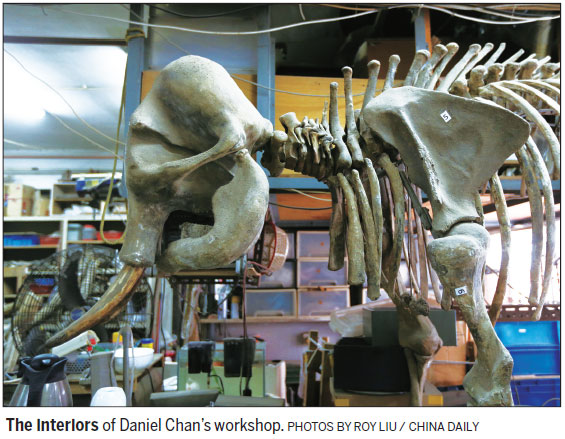
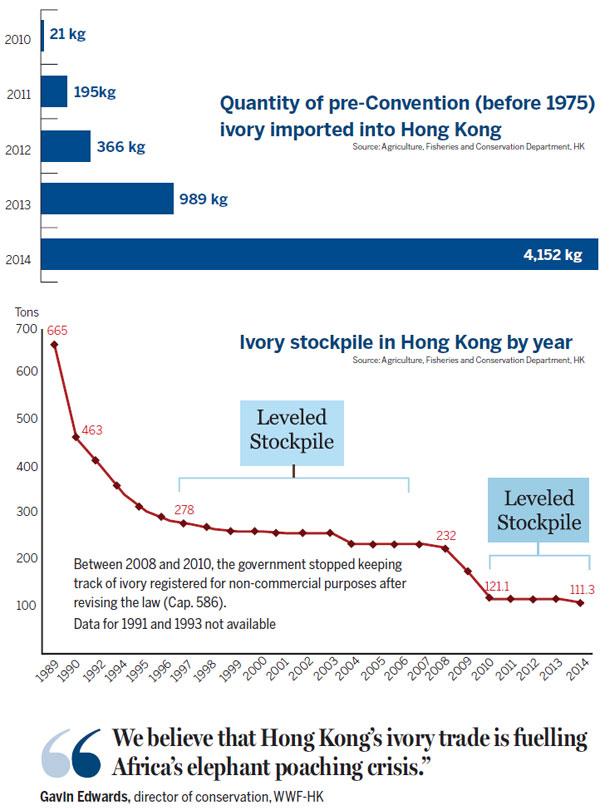
|
Only a few ivory sculptors have remained in Hong Kong's ivory trade. |

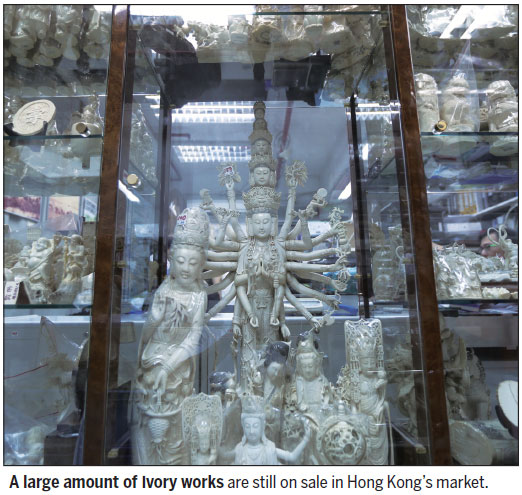
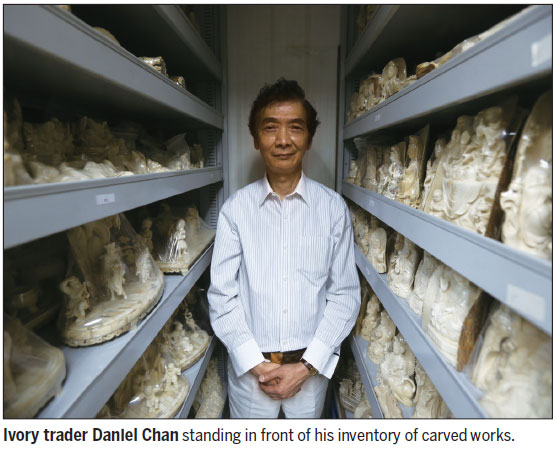
(HK Edition 10/29/2015 page8)
